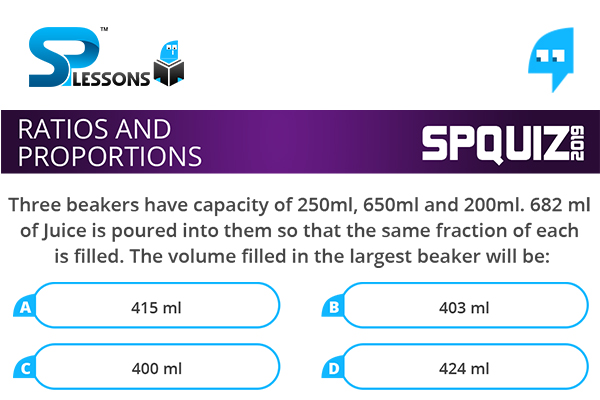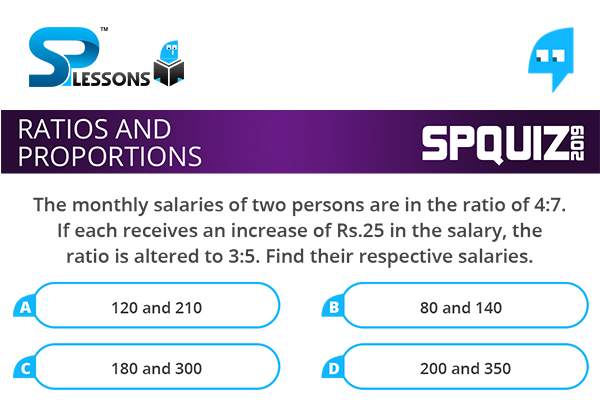 Introduction
Introduction
Ratios and Proportions is one of important topic in Quantitative Aptitude Section. In Ratios and Proportions - Quiz 5 article candidates can find questions with an answer. By solving this questions candidates can improve and maintain, speed, and accuracy in the exams. Ratios and Proportions - Quiz 5 questions are very useful for different exams such as IBPS PO, Clerk, SSC CGL, SBI PO, NIACL Assistant, NICL AO, IBPS SO, RRB, Railways, Civil Services etc.
 Q1
Q1
Three beakers have capacity of 250ml, 650ml and 200ml. 682 ml of Juice is poured into them so that the same fraction of each is filled. The volume filled in the largest beaker will be:
- A. 415 ml
B. 403 ml
C. 400 ml
D. 424 ml
As the beaker filled by the same fractions,
[latex]\frac {p}{250}[/latex] = [latex]\frac {q}{650}[/latex] = [latex]\frac {r}{200}[/latex] = [latex]\frac {p + q + r}{250 + 650 + 200}[/latex]
Thus p + q + r = 682
⇒ q = 403 ml.
 Q2
Q2
The monthly salaries of two persons are in the ratio of 4:7. If each receives an increase of Rs.25 in the salary, the ratio is altered to 3:5. Find their respective salaries.
- A. 120 and 210
B. 80 and 140
C. 180 and 300
D. 200 and 350
Let the salaries be 4x and 7x
Therefore,
[latex]\frac {4x + 25}{7x + 25} = \frac {3}{5}[/latex]
5(4x + 25) = 3(7x + 25)
20x + 125 = 21x + 75
x = 50
Therefore, their salaries are 4 × 50 and 7 × 50 i.e., 200 and 350
 Q3
Q3
The present ages of A and B are as 6:4. Five years ago their ages were in the ratio 5:3. Find their present ages.
- A. 42, 28
B. 36, 24
C. 30, 20
D. 25, 15
Go from the choices
Choice (C) 30 and 20 are in the ratio of 6:4
Five years ago their ages would be 25 and 15 which are in the ratio 5:3.
Hence choice (C) is the right answer.
 Q4
Q4
A, B and C, each of them working alone can complete a job in 6, 8 and 12 days respectively. If all three of them work together to complete a job and earn Rs.2340, what will be C’s share of the earnings?
- A. Rs.520
B. Rs.1080
C. Rs.1170
D. Rs.630
A, B and C will share the amount of Rs. 2340 in the ratio of the amounts of work done by them.
As A takes 6 days to complete the job, if A works alone, A will be able to complete [latex]{\frac {1}{6}}^{th}[/latex] of the work in a day.
Similarly, B will complete [latex]{\frac {1}{8}}^{th}[/latex] and C will complete [latex]{\frac {1}{12}}^{th}[/latex] of the work.
So, the ratio of the work done by A:B:C when they work together will be equal to [latex]\frac {1}{6}[/latex], [latex]\frac {1}{8}[/latex], [latex]\frac {1}{12}[/latex]
Multiplying the numerator of all 3 fractions by 24, the LCM of 6, 8 and 12 will not change the relative values of the three values
We get [latex]\frac {24}{6}[/latex], [latex]\frac {24}{8}[/latex], [latex]\frac {24}{12}[/latex] = 4 : 3 : 2
i.e., the ratio in which A:B:C will share Rs.2340 will be 4 : 3 : 2.
Hence, C’s share will be 29 × 2340 = Rs 520
 Q5
Q5
The ratio of incomes of Pankaj and Gauri is 3:5 and the ratio of their expenditures is 2:3. Who does save more? (You have to assume that no one takes any loan from anywhere)
- A. Pankaj
B. Gauri
C. Both save equally
D. None of these
The ratio of income of Pankaj and Gauri is 3:5. Ratio of their expenditures is 2:3 i.e 3:4.5
Had the ratio of expenditures been 3:5, ratio of savings also would have been 3:5, but since ratio of their expenditures is 3:4.5 only. Obviously savings of Gauri will be something more than [latex]\frac {5}{3}[/latex] of savings of Pankaj.
Thus Gauri is the answer.








